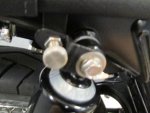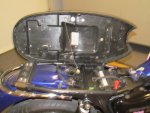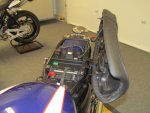CBJoe
Scooter
Hello Folks,
Done lots of searching and just need a few clarifications while troubleshooting a charging issue on my '07 Bonneville. Classic charging issue where battery goes dead after long period of riding. Pretty sure the Regulator/Rectifier has gone kaput, but here are my voltage numbers
Key Off: 12.6V
Key On: 12.3V
Idle (1400rpm): 14.2
While reving the engine to 2-6k voltage drops to 13.5V and never goes up or down from there. So system is not charging the battery while riding.
This tells me Regulator/Rectifier but I want to confirm my Stator measurements:
Across all 3 phases I get 16V at Idle and upwards of 80V and high revs. Looks good to me, but I have found reference to the 16V being lower than expected voltage at idle.
Is this normal output from the stator at appx. 1500rpm?
Cheers, Joe
PS...battery is getting replaced regardless as I dont trust it much since it was totally drained multiple times while stranding me at least 3 times with this charging issue. Will keep it around as a backup.
Done lots of searching and just need a few clarifications while troubleshooting a charging issue on my '07 Bonneville. Classic charging issue where battery goes dead after long period of riding. Pretty sure the Regulator/Rectifier has gone kaput, but here are my voltage numbers
Key Off: 12.6V
Key On: 12.3V
Idle (1400rpm): 14.2
While reving the engine to 2-6k voltage drops to 13.5V and never goes up or down from there. So system is not charging the battery while riding.
This tells me Regulator/Rectifier but I want to confirm my Stator measurements:
Across all 3 phases I get 16V at Idle and upwards of 80V and high revs. Looks good to me, but I have found reference to the 16V being lower than expected voltage at idle.
Is this normal output from the stator at appx. 1500rpm?
Cheers, Joe
PS...battery is getting replaced regardless as I dont trust it much since it was totally drained multiple times while stranding me at least 3 times with this charging issue. Will keep it around as a backup.








